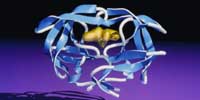
Progress and
successes
- The structures of picornaviruses, like
rhinovirus and poliovirus, form a basis
for the development of tightly-binding ligands which prevent
infection - presumably by blocking the uncoating process of the
virus. For the rhinoviruses, responsible for the common cold, the
great variability of the virus poses a tremendous challenge for
the design of a broad-spectrum drug. This variability is seen not
only in the antigenic regions but also in the ligand-binding
pocket. As well as the potential for designing a drug that
inhibits viral replication, structure-based drug design offers the
possibility of designing ligands that stabilize the virus coat,
with potential application for poliovirus vaccines. Full
implementation of the polio vaccination program in third world
countries is hampered by the thermolability of the virus used in
the vaccine, which requires the vaccine to be kept at low
temperatures, without a single interruption, from manufacturer to
injection in the patient. A ligand which would stabilize the virus
might be of tremendous value in allowing the vaccine to be exposed
to higher temperatures and thus to be more easily used in tropical
areas.
- Kim K.H. et al , Pevear D.C. : 1993,
A comparison of the anti-rhinoviral drug binding pocket in
HRV14 and HRV1A. J. Mol.
Biol. 230: 206-227.
- Caliguiri L.A. , McSharry J.J. ,
Lawrence G.W. : 1980, Effect of arildone on modifications of
poliovirus in vitro.Virology
105: 86-93.
- Dihydrofolate reductase
(DHFR) was the first target protein
solved in complex with a drug - even though the complex was a
cancer drug, methotrexate, bound to a bacterial enzyme, it was an
important first step. Three-dimensional structures of
dihydrofolate reductase have been the basis for the design of
several improved inhibitors. Both DHFR and thymidylate synthase
(TS), another enzyme involved in folate metabolism, are excellent
targets for drug design since they are crucial for pyrimidine and
purine synthesis. In the search for new cancer chemotherapeutics a
TS inhibitor with Ki = 960 nM was rationally changed into one with
Ki = 15
nM; the compound is now in clinical evaluation. Recently, the
three-dimensional structure of a bifunctional DHFR°V
thymidylate synthase from the protozoon parasite Leishmania major
has been unravelled, providing an opportunity for a two-pronged
attack for drug design for the treatment of leishmaniasis.
- Kuyper L.F. et al , Goodford P.J. :
1985, Receptor-bound design of dihydrofolate reductase
inhibitors: comparison of crystallographically determined
enzyme binding with enzyme affinity in a series of
carboxy-substituted trimethoprim analogues. J. Med. Chem.
28: 303-311.
- Webber S.E. et al , Bartlett C.A. :
1993, Design of thymidylate synthase inhibitors using protein
crystal structures: the synthesis and biological evaluation of
a novel class of 5-substituted quinazolinones. J. Med. Chem.
36: 733-746.
- Knighton D.R. et al , Matthews D.A.
: 1994, Structure and kinetic channelling in bifunctional
dihydrofolate reductase thymidylatesynthase. Nature Struct. Biol. 1: 186-194.
- A stunning example of successful improvement
of a lead compound has been published in the case of
influenza virus
neuraminidase. The investigators used
GRID to find a favorable position for adding a positively charged
substituent to the sialidase inhibitor
2-deoxy-2,3-didehydro-D-N-acetylneuraminic acid (Neu5Ac2en). This
modified saccharide not only binds over three orders of magnitude
better than the parent compound, but is also effective in vitro
and in vivo against virus infection.
- Rational design of potent
sialidase-based inhibitors of influenza virus replication.
Nature 363: 418-423.
- Structural studies on elastase have revealed
the erratic mode of binding of closely related inhibitors. Three
modifications of the same parent ligand molecule led to
surprisingly different binding modes of the three daughter
molecules.
- Mattos C., Rasmussen B., Ding X.,
Petsko G.A., Ringe D. : 1994, Analogous inhibitors of elastase
do not always bind analogously. Nature Struct. Biol. 1: 55-58.
- Thrombin provides an example where natural compounds have been
used as leads in a structure-based drug optimization process. The
three-dimensional structure of the leech inhibitor hirudin has
been the basis for the development of compounds such as 'hirulog',
a potent inhibitor of thrombin. Fragments of the natural target of
thrombin, fibrinogen, have also been incorporated into
high-affinity ligands. Surprisingly, oligonucleotides can also be
found that inhibit the activity of thrombin. The binding mode has
been unravelled in a three-dimensional structure and is likely to
allow the development of yet another family of thrombin
inhibitors.
- Nakanishi H. et al , Kahn M. : 1992,
Peptide mimetics of the thrombin-bound structure of
fibrinopeptide A. Proc. Natl.
Acad. Sci. USA.
89: 1705-1709.
- Padmanabhan K. , Padmanabhan K.P. ,
Ferrara J.D. , Sadler J.E. , Tulinsky A. : 1993, The structure
of alpha-thrombin inhibited by a 15-mer single-stranded DNA
aptamer. J. Biol.
Chem. 268:
17651-17654.
- Lam P.Y.S. et al , Erickson-Viitanen
S. : 1994, Rational design of potent, bioavailable, nonpeptide
cyclic ureas as HIV protease inhibitors. Science
263: 380-384.
- Knowledge of the three-dimensional structure
of HIV protease,
a small but crucial protein from the AIDS virus, has led to
structure-based design of nanomolar, bioavailable, non-peptide
inhibitors. Few proteins have been crystallographically studied
more frequently than this protease - there are now very many known
inhibitor-protease complexes. Interestingly, this goal-oriented
research also provides an extremely precious database of known
structures of protein-ligand complexes with associated binding
constants. This is a gold-mine for the fundamental research of
theoretical biophysicists, and will allow them to sharpen their
theoretical and computational tools. Eventually this will of
course be beneficial for improving the scoring tools in the ligand
design process.
- Lam P.Y.S. et al , Erickson-Viitanen
S. : 1994, Rational design of potent, bioavailable, nonpeptide
cyclic ureas as HIV protease inhibitors. Science
263: 380°V384.

